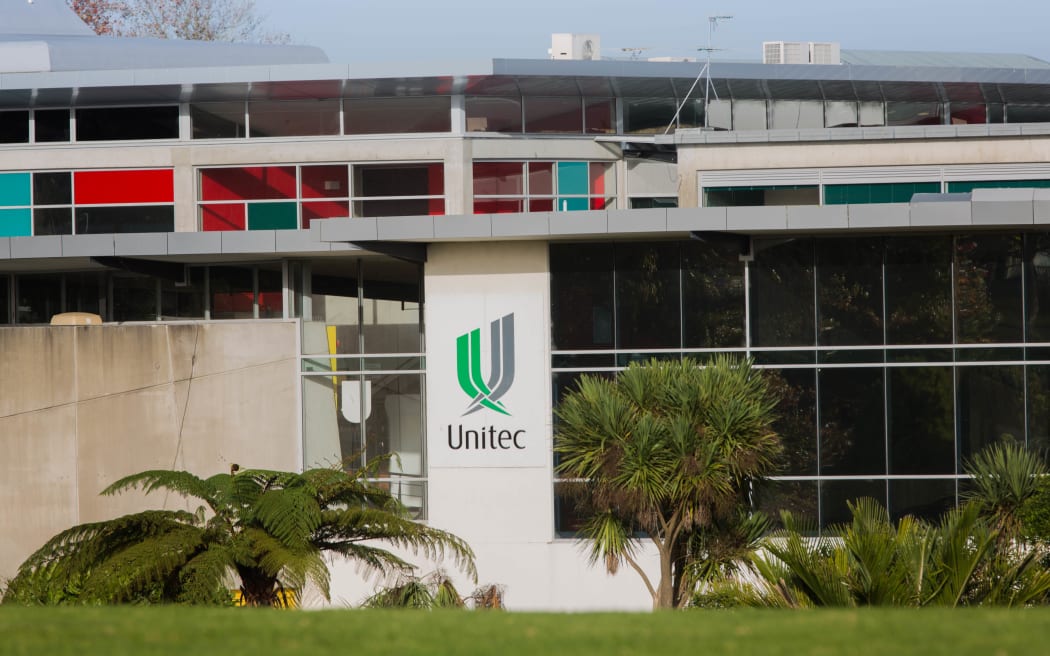For years, some of New Zealand's polytechnics have faced uncertainties about their financial viability - will the government's mega-merger of the sector mean a secure future for vocational education and training?

Auckland's Unitec has required a government bail out in recent years. Photo: RNZ / Cole Eastham-Farrelly
On January 1, the country's 16 polytechnics will be merged into a new entity, Te Pūkenga.
The New Zealand Institute of Skills and Technology is meant to be a one stop shop for vocational education and on-the-job training.
It's also meant to provide some security for the sector, which has been teetering on the edge of viability after years of financial strife.
But how did we get here? RNZ's education correspondent John Gerritsen explains to The Detail.
What is a polytech?
Polytechs, or institutes of technology as some of them are known, provide vocational education: hands-on, work-ready training and courses. Most of the qualifications are at certificate or diploma level, although some institutions do offer degrees as well.
Most regions have their own polytech. You might go there to study nursing, hospitality or mechanical engineering. Students enrolling could be school leavers, or people looking for a mid-career change.
Last year about 130,000 students were enrolled at polytechs across the country.
While there are 16 polytechs now, there used to be a lot more. Over the years, many have ended up being merged with nearby institutions. As an example, Gerritsen points to UCOL in Palmerston North, which took over the polytech in Whanganui and also has campuses in Levin and Masterton.
How are polytechs funded?
Gerritsen says polytechs get government funding for every student they enrol. How much they get per student will depend on the course they enrol in and the expenses involved - it could range from about $5000 to $8000.
On top of that, polytechs charge students a fee.
Why have polytechs ended up in so much financial strife?
As Gerritsen explains, polytechs are sensitive to enrolments cycles - when employment is high and the economy's going well, enrolments tend to drop.
But when the economy's not going so well and more people are unemployed, more people turn to polytechs to re-train or upskill.
"They tend to do better when the economy's doing worse," Gerritsen says.
In the aftermath of the global financial crisis, there was a big jump in the number of people enrolling in tertiary education.
"What happens is as they move out of that sort of cycle, as the economy improves, then suddenly their enrolments start going down and they've got to cut costs or they're going to start making deficits."
Some have been better at managing these cycles than others, Gerritsen says.
"The larger institutes were better at avoiding that sort of a situation, better at balancing that out, but it has been a real problem for many institutes over the years."
In recent years, the government has spent almost $100 million bailing out in Auckland, as well as Whitireia in Porirua and Tai Poutini on the West Coast.
Education Minister Chris Hipkins made it clear that changes were needed to ensure the sector remained viable.
The merger plan
The government wanted to ensure there were more training options and opportunities for people across the country.
As part of its reform of vocational education, Te Pūkenga - the New Zealand Institute of Skills and Technology - was born.
As well as bringing together the country's 16 polytechs, it'll also subsume industry training institutes. All up, about 200,000 students and 8000 staff will be part of Te Pūkenga when it takes over on January 1.
"Basically what the government has decided is we're not going to have any half measures, let's just go the whole hog and just have one national polytechnic," Gerritsen says.
"But it's going to be complicated, and one of the warnings was that if you put all your eggs in one basket, if the national polytechnic gets it wrong, it goes wrong for every single one of its constituent parts.
"You could say it's been a high risk strategy from that point of view, but the basic premise seems to be safety in numbers and there's going to be savings made by just having one entity."
The new entity will mean administration and back office savings, but there could also be more standardised course content - instead of each of the 16 polytechs coming up with a course on their own, it'll be done once and be used across the country.
Where are things at?
Gerritsen says we're about halfway through the process.
But there have been delays - consultation on the detailed operating model for what Te Pūkenga will look like is running late and Gerritsen says this is a source of trepidation for both the Tertiary Education Commission and the government.
"The 1st of January is rushing up and this organisation has to explain in detail how it's going to work and also what's going to be different.
"At the worst case scenario you can just keep the polytechnics running and the industry training organisations running as they were without changing anything, but that's not what Te Pūkenga's there for, it's trying to usher in this new era of vocational education and training and it has to do things differently.
"That's what the government wants to see from it and it also wants to see some savings as well because at the moment things are not looking too good financially for it."
Find out how to listen and subscribe to The Detail here.
You can also stay up-to-date by liking us on Facebook or following us on Twitter.

Photo:


